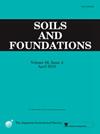Geotechnical performance of the Gounokawa River levee during the 2018, 2020, and 2021 flooding events
IF 3.3
2区 工程技术
Q2 ENGINEERING, GEOLOGICAL
引用次数: 0
Abstract
Significant sand ejecta repeatedly appeared during the 2018, 2020, and 2021 flooding events at the Gounokawa River levee in the Shimonohara district of Shimane Prefecture, Japan. Detailed site investigations were conducted, including the recording of a local resident’s eyewitness account, soil borings, electric resistivity tomography, and trench excavations. These methods clarified the event timelines, foundation soil profiles, and origins of the sand ejecta. Topographic changes, analyzed using digital elevation models derived from unmanned aerial vehicle photogrammetry, were used to determine whether backward erosion piping (BEP) had occurred. It was confirmed that high water pressure had propagated through the gravel layer and had broken through the overlying layers. Sand volcanoes formed in locations where an underlying gravel layer had existed and ground surface elevations had been low. The water head difference across the levee, when the sand boiling began, was estimated fairly accurately. This provided a valuable opportunity to verify the validity of the methods used to predict the initiation of sand boiling and BEP. The head difference was the highest in the 2018 event and decreased in the subsequent events. Despite the large amount of sand ejecta, no ground surface subsidence was observed. A grain-size distribution analysis revealed that the underlying gravel contained an unstable sand fraction, and thus, was suffusive. Most of the large amount of sand ejecta is considered to have originated from the gravel layer. Detailed trench wall observations facilitated the development of a scenario describing the ground deformation and sand-clod formation during the repeated flooding events.
Gounokawa河堤坝在2018年、2020年和2021年洪水事件中的岩土性能
在2018年、2020年和2021年的洪水事件中,日本岛根县下野原地区的古野川河堤坝反复出现了大量的沙子喷射。进行了详细的现场调查,包括记录当地居民的目击记录、土壤钻孔、电阻率断层扫描和挖掘壕沟。这些方法阐明了事件时间线、地基土壤剖面和喷砂物的起源。利用无人机摄影测量获得的数字高程模型分析地形变化,以确定是否发生了反向侵蚀管道(BEP)。证实了高压已通过砾石层传播并突破了上覆层。沙火山形成于地下砾石层存在和地表海拔较低的地方。当沙子沸腾时,堤岸上的水头差是相当准确的。这提供了一个宝贵的机会来验证用于预测砂沸腾起始和BEP的方法的有效性。在2018年的比赛中,头部差距最大,在随后的比赛中有所下降。尽管大量喷砂,但未观察到地面沉降。粒度分布分析表明,下伏砾石含有不稳定的砂粒,因此是充满的。大量的喷砂被认为大多来自砾石层。详细的海沟壁观测促进了描述反复洪水事件期间地面变形和沙块形成的情景的发展。
本文章由计算机程序翻译,如有差异,请以英文原文为准。
求助全文
约1分钟内获得全文
求助全文
来源期刊

Soils and Foundations
工程技术-地球科学综合
CiteScore
6.40
自引率
8.10%
发文量
99
审稿时长
5 months
期刊介绍:
Soils and Foundations is one of the leading journals in the field of soil mechanics and geotechnical engineering. It is the official journal of the Japanese Geotechnical Society (JGS)., The journal publishes a variety of original research paper, technical reports, technical notes, as well as the state-of-the-art reports upon invitation by the Editor, in the fields of soil and rock mechanics, geotechnical engineering, and environmental geotechnics. Since the publication of Volume 1, No.1 issue in June 1960, Soils and Foundations will celebrate the 60th anniversary in the year of 2020.
Soils and Foundations welcomes theoretical as well as practical work associated with the aforementioned field(s). Case studies that describe the original and interdisciplinary work applicable to geotechnical engineering are particularly encouraged. Discussions to each of the published articles are also welcomed in order to provide an avenue in which opinions of peers may be fed back or exchanged. In providing latest expertise on a specific topic, one issue out of six per year on average was allocated to include selected papers from the International Symposia which were held in Japan as well as overseas.
 求助内容:
求助内容: 应助结果提醒方式:
应助结果提醒方式:


